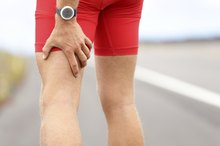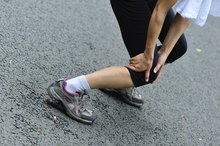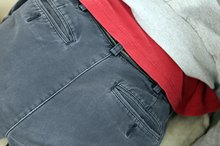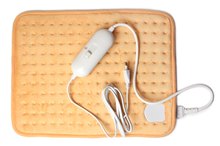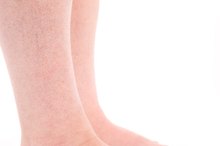Knots & Pain in Lower Leg
Knots and pain in the lower leg may occur for a variety of reasons. Some are less severe, such as muscle soreness, while others may require more extensive treatment. Athletes such as runners commonly develop knots and pain in the lower leg, as do sedentary people who are exercising for the first time. Consult your doctor if you experience pain, especially if it does not get better with rest.
If you are experiencing serious medical symptoms, seek emergency treatment immediately.
Muscle Soreness
Muscle soreness can leave your lower leg feeling tight and painful. Soreness can either be immediate or soreness that you feel shortly after exercise or delayed onset muscle soreness that you feel 24 to 48 hours after activity, according to the American Council on Exercise 1. You are especially likely to experience delayed onset muscle soreness after increasing your exercise intensity and participating in activities that require shock absorption. Dr. Cedric X. Bryant advises that researchers have not found a specific remedy that consistently alleviates soreness, but massage, stretching and ice are among possible treatments.
- Muscle soreness can leave your lower leg feeling tight and painful.
- Soreness can either be immediate or soreness that you feel shortly after exercise or delayed onset muscle soreness that you feel 24 to 48 hours after activity, according to the American Council on Exercise 1.
Trigger Points
How to Treat Severe Muscle Soreness From Weightlifting
Learn More
Trigger points are bands of muscle that are behaving differently from the rest of your muscle, forming into tight areas. Trigger points are similar to knots, but are painful to the touch. Applying pressure to trigger points may cause referred pain and muscle spasms. Dr. David Alvarez of the University of Michigan Medical School says trigger points may result from a single or multiple instances of stress to the muscle. Stress may include exercise, lack of exercise, repetitive daily activities, poor posture and nutritional deficiencies. Trigger points may limit range of motion and cause muscle weakness, and massage, ice and injections may all be used for relief.
- Trigger points are bands of muscle that are behaving differently from the rest of your muscle, forming into tight areas.
- Trigger points may limit range of motion and cause muscle weakness, and massage, ice and injections may all be used for relief.
Shin Splints
Shin splints are characterized by pain in the front of your lower leg and are caused by inflammation of your muscles and connective tissue. Runners commonly experience shin splints, and they are generally caused by increasing your exercise volume and intensity too quickly or starting activity after being sedentary, according to the University of Maryland Medical Center. Rest and ice are the main treatments for shin splints.
Compartment Syndrome
Knots After a Hard Shoulder Workout
Learn More
Your muscles are separated into compartments by thin layers of tissue called fascia. Inflammation within the compartment presses on the fascia, which does not stretch, and causes an increase in pressure within the compartment. Compartment syndrome occurs when the pressure is high enough to compress the nerves and blood vessels, restricting blood flow and potentially causing muscle and nerve damage. It may be caused by trauma or by repetitive activities like running. The University of Maryland Medical Center advises that compartment syndrome is extremely painful and may require surgery.
- Your muscles are separated into compartments by thin layers of tissue called fascia.
- Inflammation within the compartment presses on the fascia, which does not stretch, and causes an increase in pressure within the compartment.
Related Articles
References
- American Council on Exercise; What Causes Muscle Soreness and How Is it Best Relieved?; Cedric X. Bryant, Ph.D.; February 2007
- "American Family Physician"; Trigger Points: Diagnosis and Management; David J. Alvarez, D.O., et al.; February 2002
- Jafri MS. Mechanisms of myofascial pain. Int Sch Res Notices. 2014. doi:10.1155/2014/523924
- Desai MJ, Saini V, Saini S. Myofascial pain syndrome: a treatment review. Pain Ther. 2013;2(1):21-36. doi:10.1007/s40122-013-0006-y
- Celik D, Mutlu EK. Clinical implication of latent myofascial trigger point. Curr Pain Headache Rep. 2013;17(8):353. doi:10.1007/s11916-013-0353-8
- Bron, C., de Gast, A., Dommerholt, J. et al. Treatment of myofascial trigger points in patients with chronic shoulder pain: a randomized, controlled trial. BMC Med 9, 8 (2011) doi:10.1186/1741-7015-9-8
- Shah JP, Thaker N, Heimur J, Aredo JV, Sikdar S, Gerber L. Myofascial trigger points then and now: a historical and scientific perspective. PM R. 2015;7(7):746-761. doi:10.1016/j.pmrj.2015.01.024
- Oh, Sejun, et al. “Effect of Myofascial Trigger Point Therapy with an Inflatable Ball in Elderlies with Chronic Non-Specific Low Back Pain.” Journal of Back and Musculoskeletal Rehabilitation, vol. 31, no. 1, June 2018, pp. 119–126., doi:10.3233/bmr-169696.
Writer Bio
Lauren Saglimbene has been writing since 2004. She is a certified strength and conditioning specialist, certified personal trainer and certified yoga instructor. Saglimbene holds a Master of Science in strength and conditioning from Springfield College and a Bachelor of Science in biological sciences from the University of Hartford.
